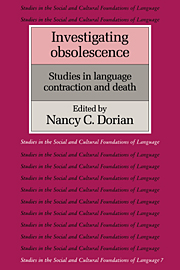Book contents
- Frontmatter
- Contents
- List of maps
- List of contributors
- Preface
- Map
- Dedication
- Introduction
- I Focus on context
- II Focus on structure
- 11 Problems in obsolescence research: The Gros Ventres of Montana
- 12 The structural consequences of language death
- 13 On signs of health and death
- 14 Case usage among the Pennsylvania German sectarians and nonsectarians
- 15 Estonian among immigrants in Sweden
- 16 The incipient obsolescence of polysynthesis: Cayuga in Ontario and Oklahoma
- 17 Urban and non-urban Egyptian Nubian: Is there a reduction in language skill?
- 18 Some lexical and morphological changes in Warlpiri
- 19 Language contraction and linguistic change: The case of Welland French
- 20 Lexical innovation and loss: The use and value of restricted Hungarian
- III Invited commentaries
- Bibliography
- Index of languages
- General index
12 - The structural consequences of language death
Published online by Cambridge University Press: 08 January 2010
- Frontmatter
- Contents
- List of maps
- List of contributors
- Preface
- Map
- Dedication
- Introduction
- I Focus on context
- II Focus on structure
- 11 Problems in obsolescence research: The Gros Ventres of Montana
- 12 The structural consequences of language death
- 13 On signs of health and death
- 14 Case usage among the Pennsylvania German sectarians and nonsectarians
- 15 Estonian among immigrants in Sweden
- 16 The incipient obsolescence of polysynthesis: Cayuga in Ontario and Oklahoma
- 17 Urban and non-urban Egyptian Nubian: Is there a reduction in language skill?
- 18 Some lexical and morphological changes in Warlpiri
- 19 Language contraction and linguistic change: The case of Welland French
- 20 Lexical innovation and loss: The use and value of restricted Hungarian
- III Invited commentaries
- Bibliography
- Index of languages
- General index
Summary
Introduction
In this chapter we are concerned with structural changes in obsolescing languages attributable to the language death process. On the basis of our experience with a number of dying languages we propose hypotheses about the characteristic structural developments within the languages concerned. These hypotheses can be confirmed, or contradicted and refined, as additional understanding of dying languages accumulates from the rapidly growing sources.
The languages of our experience upon which we base our observations are set forth below, presented with information on their geographic location, genetic affiliation, and number of speakers. Speakers' linguistic ability or structural knowledge of the obsolescing languages of this list varies greatly, and many communities exhibit a proficiency continuum ranging from fully competent speakers to individuals with very little knowledge at all. For purposes of exposition only, to give an idea of the kinds of speakers in each of the situations with which we worked, we characterize speakers roughly as S for “strong” or “(nearly) fully competent” I for “imperfect”, i.e. for reasonably fluent so-called “semi-speakers” W “weak semi-speakers” with more restricted speaking competence (perhaps akin to Elmendorf's [1981] “last speakers”); and R for so-called “rememberers” who know only few words or isolated phrases (“word-inserters” may belong to this group: see Voegelin and Voegelin 1977b). Language communities with the full proficiency continuum from S to W and/or R are presented as PC.
American Finnish PC.
(Campbell 1980)Cacaopera: El Salvador, Matagalpan branch of Misumalpan; 2 reasonably extensive R; extinct.
(Campbell 1975a and b)- Type
- Chapter
- Information
- Investigating ObsolescenceStudies in Language Contraction and Death, pp. 181 - 196Publisher: Cambridge University PressPrint publication year: 1989
- 141
- Cited by



